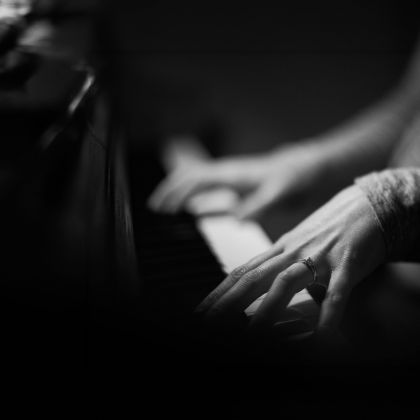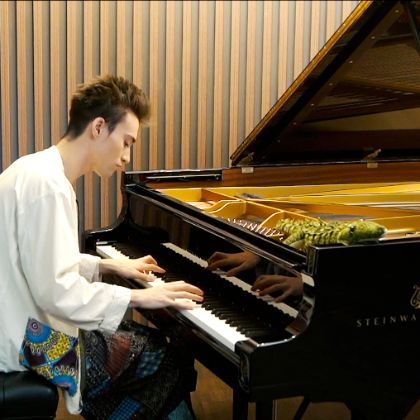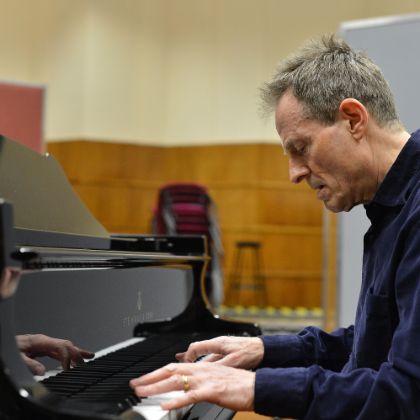Listen Magazine FEATURE
Balancing Act
Pianist Richard Goode discusses the forest and the trees of recording.
By Bradley Bambarger
One might not think of Richard Goode as a dancer; the sixty-six-year-old cuts a portly, bespectacled figure on stage. But when the pianist puts his hands to the keyboard, he is a master of rhythm, making the air move with a fluent physicality that would make a ballerina green. He is a singer of sorts, too, and not only because he tends to hum along with the music. The piano is technically a percussion instrument, but Goode, more than most players, creates the illusion of string-like legato. He even has a quirk, probably barely conscious, of wobbling a finger into a key ever-so-slightly as if adding expressive vibrato.
Now at the peak of his art, the Bronx-born Goode has in recent years added recordings of Bach and Chopin to the classic Mozart, Beethoven, Schubert and Brahms in his Nonesuch catalog. His discs rank among the least-hyped and most beautifully made of all piano recordings, the bulk of them produced by Max Wilcox, who was Arthur Rubinstein’s partner in the studio. Goode’s latest release is a long-gestated set of the five Beethoven piano concertos, made with conductor Iván Fischer and his Budapest Festival Orchestra.
Bottling the magic of music is an elusive process for even the most accomplished artists, something to which Goode is acutely sensitive. “Recording is something that I used to dread, but I’ve made my peace with it, relaxing into what it means,” he says. “I used to think of every take as ‘this is it.’ Now I just see a take as one of many possibilities.
The recording and editing process has made me a better listener. But the microphone is like a camera, in that it focuses on details you might pass over in the moment. It’s a tricky balance between the forest and the trees, because you don’t want to over-edit and break the flow of natural musicmaking.”
Liberty from obsessing over mistakes is something today’s recording artists enjoy over the players in the era of 78s, before takes could be edited. Goode points out that “you can hear the tension build after the second minute of, say, an Artur Schnabel record because, after it started well, he wouldn’t want to lose a good take. Then as now, the pressures of time and money are very real in the studio. Although a certain tension can be good, what we hear on those old records doesn’t necessarily represent the freedom of Schnabel’s true performing personality. But what I try to keep in mind is that for all the thousands of details that go into the interpretation of a score, there has to be a flow that unites them into a single expression. Without that life force, perfection in detail doesn’t really matter.”
Goode doesn’t like to describe or judge his own playing, saying that is “something easier for others to do.” But taking a break on tour, the master pianist joined Listen in looking back on some of the highlights of his discography, ruminating over the grittiness in Beethoven, the surprise in Brahms, the singing in Schubert and the dancing in Bach.
Beethoven: Piano Concertos Nos. 1–5
Budapest Festival Orchestra
Iván Fischer, conductor
2009 | Nonesuch
This set was recorded in 2005, in the Russell Johnson–designed acoustics of Budapest’s National Concert Hall, although a protracted editing process held it from release until this spring. Not able to find pianos to his liking in Budapest, Goode played the first three concertos on a beautifully restored New York Steinway found in Vienna that was once prepared for Arthur Rubinstein (and played more recently by jazzer Brad Mehldau). Goode played the final two concertos on a bigger-sounding Hamburg Steinway. Perhaps the key ingredient to the set’s success, though, is the chemistry between soloist, conductor and orchestra.
“Iván loves to rehearse and try new things, so the Budapest players don’t have an attitude of ‘we know,’ but rather of ‘we’re looking,’” Goode says. “There’s great emotional commitment to what they do. Sound-wise, the strings have this lively character, and the winds play with a soloistic quality that is rare—they realize that they’re on stage, too. In Beethoven, ‘beautiful’ orchestral playing can be too plush. Beethoven isn’t supposed to feel comfortable; it should stretch you to your limit, intellectually and emotionally. As Piatigorsky once said to a student, ‘If you want comfortable, go home to bed.’ Working with Iván and his orchestra is a visceral experience. The group has a wild side that I love.”
Mozart: Piano Concertos Nos. 9 and 25
Orpheus Chamber Orchestra
1998 | Nonesuch
Goode recorded the major Mozart piano concertos with New York’s conductorless Orpheus Chamber Orchestra; the five-disc series makes the music come alive with all its operatic promise.
“I don’t know an orchestra in the world that plays the Mozart concertos with more sensitivity and understanding than Orpheus,” Goode insists. “The quality of the ensemble’s listening is extraordinary. Working with Orpheus is a much more intense experience all around, though, whether it’s in rehearsal or when listening back and editing while recording. Because it’s a communal process, it can be complicated, with all the bassoons in the control room and so on…. As for leading an orchestra from the keyboard in Mozart, I don’t necessarily prefer it to the concertos with an orchestra and an excellent conductor. But I much prefer playing without a conductor than playing with a mediocre one.
“Of all the Mozart concertos, No. 25 is one that I have a special relationship with—it was the first one I ever played, in 1959. And I have a marvelous memory of hearing K. 503 performed by Leon Fleisher with George Szell and the Cleveland Orchestra at Carnegie Hall. A magical performance can make it seem in the moment as if the music could go no other way. Theirs had a purity, simplicity and clarity of outline from beginning to end, very elegant and elevated. I think my way with the piece is perhaps less Apollonian. But there are so many possibilities in this music.”
Brahms: Opp. 76, 116, 119
1987 | Nonesuch
The solo Brahms pieces of his Opp. 76, 116 and 119—collections of rhapsodies, capriccios and intermezzos—balance erudition and emotion like little else in the Romantic piano literature. Goode’s Brahms is one of the most rewarding items in his discography, capturing the imaginative vitality in the music but also its melancholy, his tone glowing in those moments like a candle in the gathering dark.
“I feel very close to these Brahms pieces, with their vein of autumnal introspection,” Goode says. “I know some people in the anti-Brahms faction. I think they feel offended by the emotional resignation in his music, or how his music is so thoroughly worked out. But he had so much to work out—the musical substance and deep feeling of the material completely justifies it.
“These works are so well made, flowing rhythmically much easier than, say, Schumann, despite their compositional intricacies. They are also so melodically rich, presenting a great opportunity for a pianist to sing on his instrument. Another thing that attracts me to Brahms is the irregularity of his bar lengths, which he got from Haydn, who loved variety and surprise. Brahms does the same in his way, taking you on this adventure of music.”
Schubert: Piano Sonata D. 960, Impromptus
D. 935, Allegretto in C minor
1987 | Nonesuch
The late Schubert sonatas are another Goode specialty. He has taken to performing the composer’s final, nearly forty-minute sonata again in concert, drawn not only to the D. 960’s vocal qualities but what Schumann would call Schubert’s “heavenly length.”
“The sheer breadth of Schubert’s B-flat Sonata is a challenge in that it requires so much concentration,” Goode explains. “But it feels more natural as I get older, the ability to sense time as a whole. And to go through the work with an audience along feels very satisfying to me. It’s Schubert’s last sonata, yet it’s not all about death, as some people say. Did he know it would be his last one? I think the music touches on mortality, yes, but it also has room for wit and waywardness. And then there is the cantabile quality to its long lines, especially in the first movement, with the lyrical being expanded into sonata form. The B-flat really is a sung sonata, or a song sonata.”
J.S. Bach: Partitas Nos. 1, 3 and 6
2003 | Nonesuch
In a sense, Bach’s keyboard partitas were world music before there was such a term, being suites of age-old international dance forms—from the German Allemande and French Courante to the Spanish Sarabande and Irish Gigue. Although he came late to recording Bach, Goode invested much attention in finding the right style for his two-disc survey of Bach’s six Partitas. Asked if playing Bach’s music is a Zen experience for him, Goode laughs: “That’s very funny. Nothing is Zen for me.
“As you get older, there are technical aspects to playing the piano that become more difficult,” Goode says. “But your understanding does grow with experience. You become more aware of what needs to be done. I made so many takes of the Partitas, six or seven of each movement, with more than twenty on a disc. Presenting the architecture of the music in a varied way is so important, and to do it with a sense of movement and polyphonic clarity. Bach left so few indications of how this music should sound; compared to a composer like Brahms, who tells you so much dynamically, there are virtually none. A lot of imagination is required, but with freedom comes responsibility. You have to take the time to feel where the voices are, where the most weight should be.
“When I think of beautiful Bach playing, I think of Edward Aldwell, who recorded The Well-Tempered Clavier and Goldberg Variations for Nonesuch. There isn’t just technical clarity in his playing; he conveyed the power of the music as if he had lived through its message. I also think of Edwin Fischer’s Bach playing. But the music can take so many
different approaches. Like every great composer, Bach is bigger than his interpreters. That’s something that we all, players and listeners, should remember.”
This article originally appeared in Listen: Life with Music & Culture, Steinway & Sons’ award-winning magazine.
related...
-

Practice, Practice, Practice
Steinway Artists on the Rewards of Routine
by Laura Lee Smith
Read More -

Steinway Artist - Jacob Collier: Little Blue
Read More -

Steinway Artist - John Paul Jones
John Paul Jones (born John Baldwin on January 3, 1946) became a prolific music director and arranger of a range of prominent Sixties artists before forming Led Zeppelin with Jimmy Page in 1968. Since 1980, the multi-instrumentalist embarked on a solo career, and his collaborators have included the supergroup Them Crooked Vultures as well as Paul McCartney, Brian Eno, and Diamanda Galas.
Read More